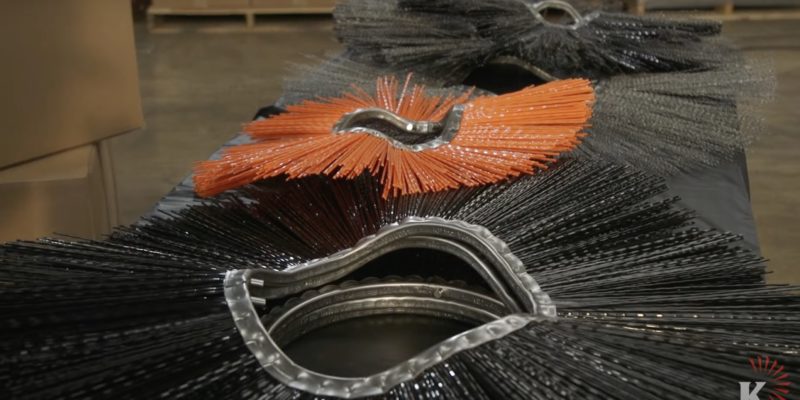Brooms are the core of any street sweeper. There are many different types of street sweepers for different sweeping applications and each one uses a replacement broom. There are four main styles of street sweeping brooms. We’ve developed an educational series called Everything You Need to Know About Street Sweeping Brushes to help educate folks in our industry on the different types of broom options. This post will focus on Wafer Brooms.
Wafers are individual broom sections that stack together on a wafer rack to make a full width broom core. Wafers are typically used to make brooms for sweeper attachments and brooms for road construction sweepers that vary in length. Wafers are a cost efficient way to make a broom. They’re compact, easy to install and economical to ship.
There are three main things to know about Wafer Brooms.
- Dimensions
- Style of Ring
- Type of Bristle Fill
The first thing to know about a wafer is how it’s measured. There are two things to focus on, the outside diameter or OD and the inside diameter or ID. Let’s start with the ID. There are a few standard ID sizes, 6 3/8”, 7”, 8 1/4” and 10”. Next we need to look at the OD of the broom. If possible, you want to measure a new broom because as the broom wears with use, the OD changes and gets smaller. Some typical wafer diameters are 21”, 24”, 26”, 27”, 32” and 36”. While there are other ID’s and OD’s, these sizes are a few of the commons ones.

The next area of focus is the wafer style. Here we’re looking at the inside ring of the wafer which can be made in two ways – a flat style or a convoluted style.
The flat wafer typically mounts with a spacer in between each wafer; wafer, spacer, wafer spacer, and so on. Flat wafers have one pin in the ring and since the are flat they do not need to be placed on the wafer rack in any particular order. The rule of thumb is to alternate as you place them on the rack. See video for a demonstration. Also note that for a denser broom, you can remove the spacer.
The convoluted wafer doesn’t need a spacer due the wavy design of the ring. There are two pins inside the ring of the convoluted wafer that are designed to help with the placement of each wafer on the wafer rack. The convoluted design has high and low spots around the ring that need to line up correctly with each other so that a spacer in not needed. Each wafer is rotated a quarter turn on a standard 4-bar wafer rack. This allows the high spots on one wafer to match up the the low spots of the next wafer.
The third thing to know about a wafer is the bristle type. There are three types of bristle; all poly, all wire, and a combo poly/wire wafer.
An all poly wafer is consider the standard for all sweeping and is the most popular type of wafer bristle. Keystone’s poly bristle has a high level of flick and rigidity which allows for great performance and long life.
The wire wafer is designed for a more aggressive sweep where more action is need to cut through mud packed in the road or for sweeping heavy millings. Wire wafers are never used alone to make a complete broom. They are used in conjunction with an poly wafer; one poly, one wire, one poly, one wire, and so on. This system works with both flat and convoluted wafers.
The third option is the combo poly/wire wafer. This option gives the same sweeping results you get with individual poly and wire wafers. The benefit is that you have the benefits of both wafers in one. This means that you only need to carry one inventory and you have an easier time changing the broom.
Wafers are sold by the box. Depending the size wafer you can expect 24, 25, or 28 wafers in a box. Please note that spacers are not included with the wafer. The reason for this is that the spacer are re-usable and do not need to be changed every time the wafers are changed.
We hope you’ve learned a little more about wafers. Please contact us anytime with further questions related to wafers or any other street sweeping brooms.

